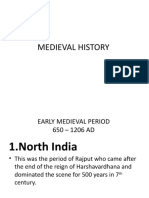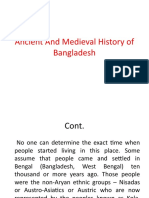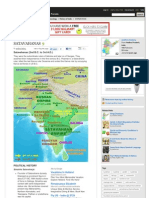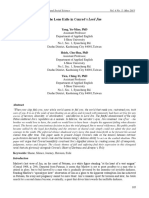Professional Documents
Culture Documents
Satavahanas: Important Rulers of The Satvahana Dynasty
Satavahanas: Important Rulers of The Satvahana Dynasty
Uploaded by
Angad Kumar0 ratings0% found this document useful (0 votes)
93 views4 pagesThe Satavahana dynasty ruled from the 3rd century BC to the 2nd century AD over present-day Andhra Pradesh, Telangana, and Maharashtra. They were the first Indian rulers to issue coins with ruler portraits. An important ruler, Gautamiputra Satakarni, defeated foreign invaders and expanded the empire. The administration was based on religious texts and included the king, princes, military leaders, and bureaucrats. Agriculture was the economic backbone while Hinduism and Buddhism were practiced. The dynasty fragmented after the last major ruler, Pulamavi IV, in 225 AD.
Original Description:
Original Title
Satavahanas1.pdf
Copyright
© © All Rights Reserved
Available Formats
PDF, TXT or read online from Scribd
Share this document
Did you find this document useful?
Is this content inappropriate?
Report this DocumentThe Satavahana dynasty ruled from the 3rd century BC to the 2nd century AD over present-day Andhra Pradesh, Telangana, and Maharashtra. They were the first Indian rulers to issue coins with ruler portraits. An important ruler, Gautamiputra Satakarni, defeated foreign invaders and expanded the empire. The administration was based on religious texts and included the king, princes, military leaders, and bureaucrats. Agriculture was the economic backbone while Hinduism and Buddhism were practiced. The dynasty fragmented after the last major ruler, Pulamavi IV, in 225 AD.
Copyright:
© All Rights Reserved
Available Formats
Download as PDF, TXT or read online from Scribd
Download as pdf or txt
0 ratings0% found this document useful (0 votes)
93 views4 pagesSatavahanas: Important Rulers of The Satvahana Dynasty
Satavahanas: Important Rulers of The Satvahana Dynasty
Uploaded by
Angad KumarThe Satavahana dynasty ruled from the 3rd century BC to the 2nd century AD over present-day Andhra Pradesh, Telangana, and Maharashtra. They were the first Indian rulers to issue coins with ruler portraits. An important ruler, Gautamiputra Satakarni, defeated foreign invaders and expanded the empire. The administration was based on religious texts and included the king, princes, military leaders, and bureaucrats. Agriculture was the economic backbone while Hinduism and Buddhism were practiced. The dynasty fragmented after the last major ruler, Pulamavi IV, in 225 AD.
Copyright:
© All Rights Reserved
Available Formats
Download as PDF, TXT or read online from Scribd
Download as pdf or txt
You are on page 1of 4
Satavahanas
• The Satavahana rule is believed to have started around the third
century BC, in 235 BC and lasted until the second century AD.
• They are referred to as Andhras in the Puranas.
• The Satavahana kingdom chiefly comprised of modern-day Andhra
Pradesh, Telangana and Maharashtra. At times, their rule also
included parts of Karnataka, Gujarat and Madhya Pradesh.
• Their capital cities varied at different times. Pratishthana (Paithan)
and Amaravati were its capitals.
• Simuka founded the dynasty.
• They were the first native Indian rulers to issue their own coins
with the portraits of the rulers.
• This practice was started by Gautamiputra Satakarni who derived
the practice from the Western Satraps after defeating them.
• The coin legends were in Prakrit language. Some reverse coin
legends are in Telugu, Tamil and Kannada.
• They patronised Prakrit more than Sanskrit.
• They supported both Buddhism and Brahminism although they
were Hindus and claimed Brahminical status.
• They successfully defended their territories against foreign invaders
and had many on-going battles with the Sakas (Western Satraps).
Important Rulers of the Satvahana dynasty
Satakarni I (180 – 124 BC)
• Satakarni I was the third Satavahana king.
• Satakarni I was the first Satavahana king to expand his empire by
military conquests.
• He conquered Kalinga after the death of Kharavela.
• He also pushed back the Sungas in Pataliputra.
• He also ruled over Madhya Pradesh.
• After annexing the Godavari Valley, he assumed the title of ‘Lord of
Dakshinapatha’.
• His queen was Nayanika who wrote the Naneghat inscription which
describes the king as Dakshinapathapati.
• He performed Ashvamedha and revived Vedic Brahminism in the
Deccan.
Hala
• King Hala compiled the Gatha Saptashati. Called Gaha Sattasai in
Prakrit, it is a collection of poems with mostly love as the theme.
Around forty of the poems are attributed to Hala himself.
• Hala’s minister Gunadhya composed Brihatkatha.
Gautamiputra Satakarni (106 – 130 AD or 86 – 110 AD)
• He is considered the greatest king of the Satavahana dynasty.
• He defeated the Greeks, Pahlavas (Indo-Parthians) and the Sakas.
• His kingdom ran from Krishna in the south to Malwa and Saurashtra
in the north and from Berar in the east to the Konkan in the west.
• He defeated Nahapana, an important king of the Western Satraps.
• He is also called Ekabrahmana.
• His mother was Gautami Balasri and hence his name Gautamiputra
(son of Gautami).
• He was succeeded by his son Vasisthiputra Sri Pulamavi or Pulamavi
II.
Administration of the Satvahana dynasty
The administration of the Satvahana dynasty was entirely based on the
Shastras which has the following structure:
1. Rajan or the king who is the ruler
2. Princes or Rajas who had their names inscribed on coins
3. Maharathis, who had the power of granting villages and also had
the privilege of maintaining marital relations with the ruling family.
4. Mahasenapati
5. Mahatalavara
The inscription of the ruler Guatamipurna Satakrni threw some light on
the bureaucratic structure of administration. However, clarity on the
detailed structure is still awaited by historians.
Economy
Agriculture was the backbone of the economy during the rule of
Satvahana kings. They also relied on trade and production of various
commodities within and outside India.
Religion & Language
The Satvahanas belonged to Hindu religion and Brahmanical caste. But,
the interesting fact is their generosity towards other caste and religion
which is evident from the donations made by them towards the Buddhist
monasteries. Many Buddhist monasteries were constructed during the
rule of the Satvahana dynasty.
The Language used during that period was “Prakrit” which is a modern
version of the Indo-Aryan Language. Political inscriptions also threw some
light on the rare use of Sanskrit Literature.
Decline of the Satavahanas
• Pulamavi IV is considered the last king of the main Satavahana line.
• He ruled until 225 AD. After his death, the empire fragmented into
five smaller kingdoms.
You might also like
- Creating A Brand Identity A Guide For Designers (Graphic Design Books, Logo Design, Marketing) PDFDocument161 pagesCreating A Brand Identity A Guide For Designers (Graphic Design Books, Logo Design, Marketing) PDFabcd_xyzxyz100% (19)
- Onward Towards Our Noble DeathsDocument361 pagesOnward Towards Our Noble DeathsVersatile Indian Films83% (6)
- The First Book of DisciplineDocument1 pageThe First Book of Disciplinefederico scaranoNo ratings yet
- NCERT Notes - Satavahana Dynasty Post Mauryan Period Ancient Indian History Notes For UPSCDocument5 pagesNCERT Notes - Satavahana Dynasty Post Mauryan Period Ancient Indian History Notes For UPSCRamya KonaNo ratings yet
- SatavahanasDocument7 pagesSatavahanasDiksha DwivediNo ratings yet
- NCERT Notes Satavahana Dynasty Post Mauryan Period PDFDocument3 pagesNCERT Notes Satavahana Dynasty Post Mauryan Period PDFkumarajaNo ratings yet
- Satavahana Dynasty Upsc Notes 66Document5 pagesSatavahana Dynasty Upsc Notes 66Ramya KonaNo ratings yet
- Early Medieval IndiaDocument14 pagesEarly Medieval IndiaSharath sharuNo ratings yet
- Satavahana DynastyDocument9 pagesSatavahana DynastyAnudeepManiyaramNo ratings yet
- Civilization 5Document5 pagesCivilization 5Brinzei LucianNo ratings yet
- Gupta Empire: by DR Vipan GoyalDocument38 pagesGupta Empire: by DR Vipan GoyalHarshit RajNo ratings yet
- The Post-Gupta Period: By-Manish ShrivastavaDocument15 pagesThe Post-Gupta Period: By-Manish ShrivastavaMayank Dwivedi100% (1)
- 07 - Chapter 2Document22 pages07 - Chapter 2Azimul Aktar BarbhuiyaNo ratings yet
- Medieval History 01 - Daily Class Notes (Sankalp (UPSC 2024) )Document13 pagesMedieval History 01 - Daily Class Notes (Sankalp (UPSC 2024) )anuraghavsingh01No ratings yet
- Post Mauryan PeriodDocument22 pagesPost Mauryan PeriodSwarlatha PandeyNo ratings yet
- Rise of Satavahana, Gautamiputra SatakarniDocument7 pagesRise of Satavahana, Gautamiputra SatakarniKaiNo ratings yet
- Medieval History Updated-English PrintableDocument67 pagesMedieval History Updated-English Printablembawork793No ratings yet
- Shung, Kanva & Satvahana Dyansty Rule in IndiaDocument11 pagesShung, Kanva & Satvahana Dyansty Rule in IndiaAquib IrshadNo ratings yet
- Ancient History 19 - Daily Class NotesDocument10 pagesAncient History 19 - Daily Class Notesamankgaya157No ratings yet
- Unit-I The Maukharis, Vakatas, Chaulukyas and Later GuptasDocument22 pagesUnit-I The Maukharis, Vakatas, Chaulukyas and Later GuptasLalhruaitluanga 138No ratings yet
- Gupta Empire Upsc Notes 32Document4 pagesGupta Empire Upsc Notes 32William StainsNo ratings yet
- Ch-6 The Age of Gupta'sDocument6 pagesCh-6 The Age of Gupta'sSumit Singh50% (2)
- Gupta Age Post Gupta Age Harsha Age Early Medieval Kingdoms 1 97Document12 pagesGupta Age Post Gupta Age Harsha Age Early Medieval Kingdoms 1 97SeemaNo ratings yet
- RashtrakutasDocument35 pagesRashtrakutasamrit ranjan alehNo ratings yet
- Early Medieval IndiaDocument19 pagesEarly Medieval IndiaIndianhoshi HoshiNo ratings yet
- Medieval India PDFDocument24 pagesMedieval India PDFMohit JainNo ratings yet
- Origin of Rajput StatesDocument12 pagesOrigin of Rajput Statespyush6202No ratings yet
- Tripartite StruggleDocument37 pagesTripartite Strugglesubham ghoshNo ratings yet
- Tripartite StruggleDocument15 pagesTripartite StruggleGusto EriolasNo ratings yet
- Ap History Govt Data PDFDocument31 pagesAp History Govt Data PDFgajaNo ratings yet
- PresentationDocument8 pagesPresentationGagandeep Singh JassNo ratings yet
- Iasbaba'S Prelims Exclusive PROGRAM (PEP) 2022: Medieval History HandoutsDocument11 pagesIasbaba'S Prelims Exclusive PROGRAM (PEP) 2022: Medieval History HandoutsGagandeep KumarNo ratings yet
- 2 Early Medieval IndiaDocument37 pages2 Early Medieval IndiaRajat KumarNo ratings yet
- CBSE Notes Class 6 History Chapter 10 - New Empires and KingdomDocument3 pagesCBSE Notes Class 6 History Chapter 10 - New Empires and KingdomSHAILYNo ratings yet
- Telangana HistoryDocument11 pagesTelangana HistoryChandrakanth ThoshniwalNo ratings yet
- Andhra Pradesh HistoryDocument45 pagesAndhra Pradesh Historyvishwanath100% (2)
- Gay Times UK - April 2019Document18 pagesGay Times UK - April 2019ashok krNo ratings yet
- History (750-1000AD) : Early Medieval Northern India (Period From C. 750 - 1000 CE)Document7 pagesHistory (750-1000AD) : Early Medieval Northern India (Period From C. 750 - 1000 CE)Sk Habibur RahamanNo ratings yet
- The Mahameghavahana DynastyDocument3 pagesThe Mahameghavahana DynastyBrinzei LucianNo ratings yet
- Western GangasDocument13 pagesWestern GangasVani MadhuKiranNo ratings yet
- History Class7 TN BoardDocument74 pagesHistory Class7 TN BoardSubhranshu Shekhar100% (1)
- HIS 2172-Early MedievalDocument10 pagesHIS 2172-Early Medievalkaushal yadavNo ratings yet
- History Gupta Empire 2 PDF Lyst1819Document22 pagesHistory Gupta Empire 2 PDF Lyst1819soumyathepowerhouseNo ratings yet
- Medieval HistoryDocument78 pagesMedieval HistoryParnab NaskarNo ratings yet
- Ancient and Medieval History of BangladeshDocument37 pagesAncient and Medieval History of BangladeshMahfuzul saimonNo ratings yet
- Handout On Gupta and Post Gupta AgeDocument6 pagesHandout On Gupta and Post Gupta AgebellawillchesterkittyNo ratings yet
- Medival History PDFDocument84 pagesMedival History PDFclinfoxNo ratings yet
- The Historical BackgroundDocument31 pagesThe Historical BackgroundVijay BungaNo ratings yet
- SatvahanasDocument7 pagesSatvahanasVishnu VardhanNo ratings yet
- General AwarenessDocument116 pagesGeneral AwarenessUma ShankarNo ratings yet
- Ncert Notes: Medieval History - The North Indian Kingdoms - The RajputsDocument47 pagesNcert Notes: Medieval History - The North Indian Kingdoms - The RajputsMathiraja.TNo ratings yet
- Satavahanas: Satavahanas (2nd B.C. To 3rd A.D.)Document6 pagesSatavahanas: Satavahanas (2nd B.C. To 3rd A.D.)Anuswadh Srinivasan MNo ratings yet
- 6 - (JAN) S - SC - L-11 THE GUPTA & THE POST-GUPTA PERIOD (H) - NOTES - PRIYA - JDocument4 pages6 - (JAN) S - SC - L-11 THE GUPTA & THE POST-GUPTA PERIOD (H) - NOTES - PRIYA - JTanvika AroraNo ratings yet
- New Microsoft Office Word DocumentDocument38 pagesNew Microsoft Office Word DocumentSANDEEP100% (1)
- Introduction AP History For All Appsc Exam OnlyDocument8 pagesIntroduction AP History For All Appsc Exam OnlyChintha SreenivasuluNo ratings yet
- Ancient History of Bengal Lec - 02Document5 pagesAncient History of Bengal Lec - 02abdzawad00007No ratings yet
- Medieval Indian HistoryDocument73 pagesMedieval Indian HistoryAnonymous x869mKNo ratings yet
- Satavahana Dynasty - Introduction, History, Rulers, FAQs - GeeksforGeeksDocument4 pagesSatavahana Dynasty - Introduction, History, Rulers, FAQs - GeeksforGeeksSasmita BehuriaNo ratings yet
- Gupta EmpireDocument6 pagesGupta EmpireRohit SharmaNo ratings yet
- Gupta EmpireDocument6 pagesGupta EmpireSasikalaNo ratings yet
- Andhra Pradesh HistoryDocument32 pagesAndhra Pradesh Historymohankrishna7550% (2)
- The Early Medieval India: The Age of The Regional Configuration (C. 600-1200 CE)Document19 pagesThe Early Medieval India: The Age of The Regional Configuration (C. 600-1200 CE)PrasamNo ratings yet
- Indus Valley CivilizationDocument8 pagesIndus Valley CivilizationAngad KumarNo ratings yet
- Vedic Age Mahajan A Padas and Magadha EmpireDocument38 pagesVedic Age Mahajan A Padas and Magadha EmpireAngad KumarNo ratings yet
- Mughalempire PDFDocument20 pagesMughalempire PDFAngad KumarNo ratings yet
- Rule in North and North Western India During 200 B.C To 300 A.D Indo-GreeksDocument52 pagesRule in North and North Western India During 200 B.C To 300 A.D Indo-GreeksAngad KumarNo ratings yet
- Invasion of Arab and Turks in IndiaDocument20 pagesInvasion of Arab and Turks in IndiaAngad KumarNo ratings yet
- Buddhism and JainismDocument9 pagesBuddhism and JainismAngad KumarNo ratings yet
- Marco Durathon III Catalog 1986Document20 pagesMarco Durathon III Catalog 1986Alan MastersNo ratings yet
- Essay WritingDocument2 pagesEssay WritingJason AndoyoNo ratings yet
- of RajasthanDocument17 pagesof RajasthanVishakha SharmaNo ratings yet
- Lord Jim Critique Academic ArticleDocument7 pagesLord Jim Critique Academic Articlestuart001No ratings yet
- Screening Test, Grade 5Document2 pagesScreening Test, Grade 5Nard LastimosaNo ratings yet
- Citation End Text Reference1Document28 pagesCitation End Text Reference1Prashanth JagadeeshNo ratings yet
- Material ExplorationDocument39 pagesMaterial ExplorationGabi Morgenstern100% (1)
- Soal UjianDocument7 pagesSoal UjianTari SulaimanNo ratings yet
- Italy-Air Victories WW2Document33 pagesItaly-Air Victories WW2Bobby Chipping100% (2)
- Change The Following Nominal Sentences Into The Correct FormsDocument3 pagesChange The Following Nominal Sentences Into The Correct FormsIstiqomahNo ratings yet
- Aferim Epk PDFDocument13 pagesAferim Epk PDFqazqazqaz123123123No ratings yet
- Bar Exam Results Feb 29, 2012Document44 pagesBar Exam Results Feb 29, 2012jems_fernNo ratings yet
- Young Violin 3Document21 pagesYoung Violin 3Hong CeeNo ratings yet
- E-Book Proof of Design DFM and Concurrent EngineeringDocument425 pagesE-Book Proof of Design DFM and Concurrent Engineeringsmtdrkd100% (7)
- The Man Who Escapaed 9 & 10Document6 pagesThe Man Who Escapaed 9 & 10Angel SalhuteruNo ratings yet
- La Circulation Monétaire À Strasbourg (France) Et Sur Le Rhin Supérieur Au Premier Siècle Après J.-C. / Stéphane MartinDocument28 pagesLa Circulation Monétaire À Strasbourg (France) Et Sur Le Rhin Supérieur Au Premier Siècle Après J.-C. / Stéphane MartinDigital Library Numis (DLN)No ratings yet
- A Fine Placement TestDocument6 pagesA Fine Placement TestNesrinnil100% (1)
- Kastri 12: Study PlansDocument19 pagesKastri 12: Study PlansGEORGE KARYDIS0% (1)
- The Glory of Badrinath - 3Document6 pagesThe Glory of Badrinath - 3Vande MataramNo ratings yet
- Reading 1Document11 pagesReading 1Muhammad ShadiqNo ratings yet
- An Introduction To The Bible - Revised Edition (PDFDrive)Document381 pagesAn Introduction To The Bible - Revised Edition (PDFDrive)Aaron Sweet100% (2)
- Frontmatter From The Cambridge Companion To ChopinDocument12 pagesFrontmatter From The Cambridge Companion To ChopinEduard GavrilNo ratings yet
- One Point Perspective CubeDocument4 pagesOne Point Perspective Cubedigdug93No ratings yet
- Amalfi Guide SorrentoDocument11 pagesAmalfi Guide Sorrentoalwssa12No ratings yet
- Yongey Mingyur Rinpoche's New BookDocument6 pagesYongey Mingyur Rinpoche's New BookSutheeRattanamongkolgulNo ratings yet
- Anorak PatternDocument22 pagesAnorak Patterngoordye100% (3)
- Fight SongDocument1 pageFight SongArjel JamiasNo ratings yet































































































